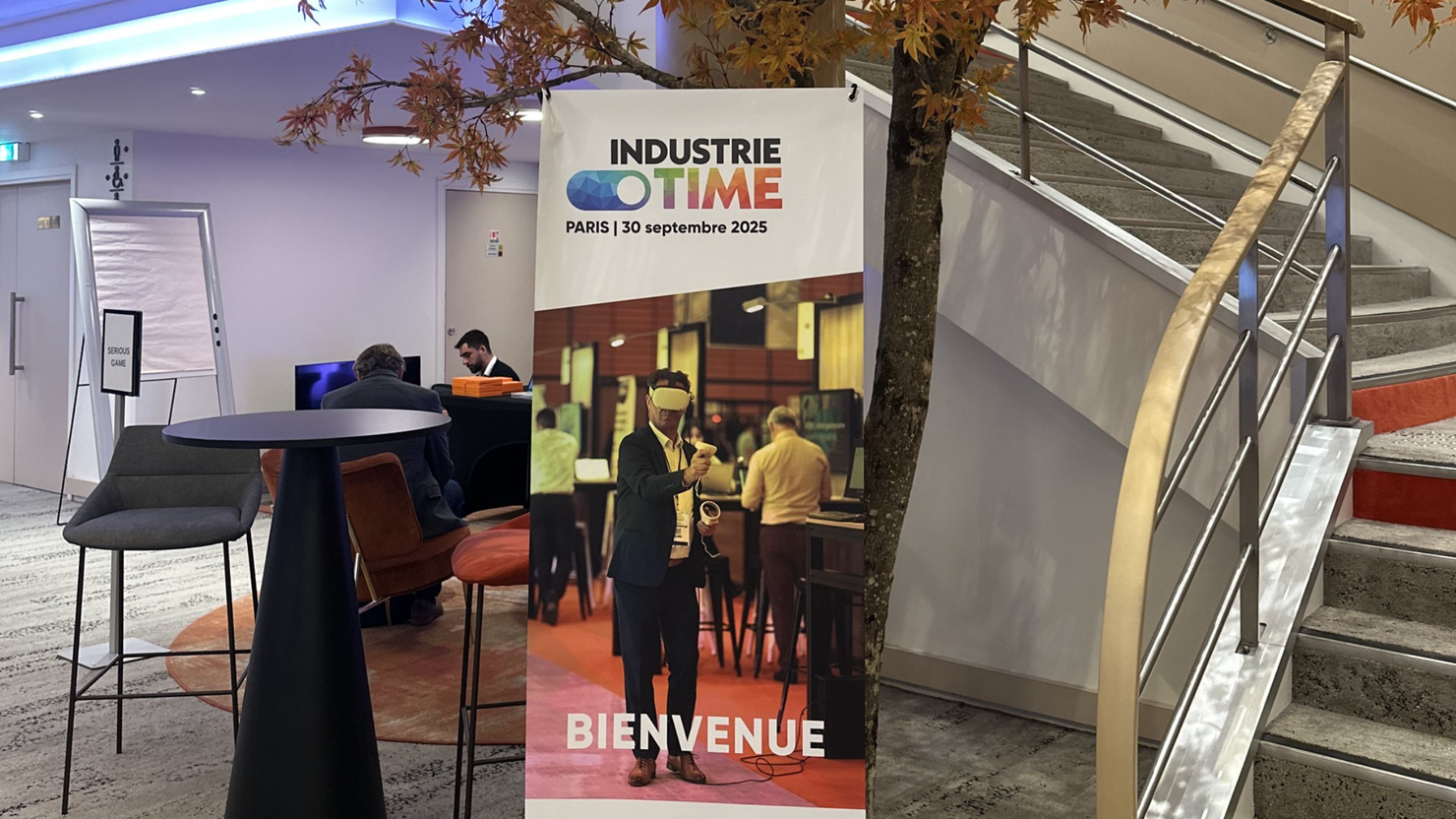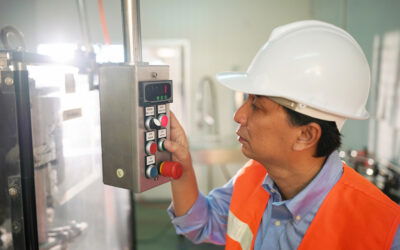Back to Industrie Time Paris 2025
One month after Industrie Time Paris: OEE industry at the heart of transformation
One month ago, on September 30, 2024, Industrie Time Paris brought together the players in Industry 4.0. François Coulloudon, CEO of TEEPTRAK, shared a clear vision: the data-driven factory is no longer a futuristic concept, but a necessity for survival in an unstable economic context.
Discussions with manufacturers and feedback from the field confirm that the OEE are no longer simple monitoring indicators, but the strategic pillars of competitiveness.
This article explains how TEEPTRAK responds to this urgent need for performance management, with concrete examples of OEE implementation and analysis in different industrial sectors.
Relive François Coulloudon’s full speech at Industrie Time Paris 2024
Defining and calculating OEE: the plant performance indicator
Understanding OEE and its place in industry
OEE (Overall Equipment Effectiveness) is the performance indicator that measures the real efficiency of a piece of equipment. As François Coulloudon reminds us: “OEE takes up the notion of added value. In a company, everything people do must produce value.”
This indicator has established itself as a benchmark in the manufacturing industry, as it enables precise measurement of the actual utilization of production equipment. Unlike a simple count of the number of parts produced, the OEE reveals the hidden losses that impact profitability.
The OEE calculation formula: availability, performance and quality
OEE = Availability Rate × Performance Rate × Quality Rate
- Availability rate: actual operating time / required time
- Performance rate: (number of parts produced × theoretical cycle time) / operating time
- Quality rate: number of compliant parts / total number of parts produced
This breakdown enables a precise analysis of losses. For example, a machine may run for 8 hours (good availability) but produce only 80% of the expected number of parts (performance problem), including 5% rejects (quality problem).
The three types of loss that impact production
The losses that reduce the OEE fall into distinct categories:
Losses in availability: breakdowns, planned stoppages, series changes, tool changeover times. These losses reduce the machine’s effective uptime.
Performance losses: rate deviations, micro-stops, slowdowns. The machine is running, but below its theoretical output, which reduces part production.
Quality losses: rejects, rework, start-ups. Parts are produced but do not conform, wasting material and time.
Automated dashboards can capture these losses in real time, unlike manual Excel-based methods which consume 5 to 15 hours a week without bringing any value to decision-making. Production managers spend more time compiling reports than analyzing root causes.
OEE TEEPTRAK solution: digital implementation demonstrated at Industrie Time Paris
A plug & play IoT system for any production line
The TEEPTRAK stand at Industrie Time Paris demonstrated instant connection on various types of machine. This application-based software solution connects any equipment at competitive prices (€2,000 to €3,000 per machine, including hardware).
Set-up is rapid, thanks to non-intrusive sensors that detect machine status without modification. TEEPTRAK has subsidiaries in Chicago and China to support international deployments.
This solution addresses the three major concerns expressed by production managers at Industrie Time Paris:
Universal compatibility: works on old and new machines, whatever the type of existing system. Sensors adapt to all industrial protocols.
Rapid deployment: installation in just a few hours per machine, measurable results in 90 days. The Hutchinson example shows significant gains in less than 6 months.
Operational autonomy: operators use the tool directly on their tablet or workshop screen, without having to rely on the IT department to access production data.
Real-time communication and display of part numbers
The TEEPTRAK software digitizes the concept of the Takt Board, the physical table that used to manually indicate the number of parts produced per hour versus the number planned.
The solution automates this communication process:
- Automatic detection of machine cycles and calculation of part numbers
- Real-time calculation of speed deviations and identification of stoppages
- Feedback on causes of stoppages (jamming, waiting for material, adjustment)
- Instant visualization of OEE on workshop screen with availability-performance-quality breakdown
This transparency transforms the way data is used: instead of discovering problems 24 or 48 hours later via an Excel report, teams react immediately.
OEE analysis and continuous improvement: an example of implementation at Hutchinson
Managerial routines that make all the difference
François Coulloudon insists: “To improve performance, you need effective management routines. It’s crucial to know how to escalate problems and set up escalation processes.”
Setting up structured routines ensures that OEE data analysis leads to concrete action. Two elements are essential:
Background: training teams in indicator interpretation. TEEPTRAK software makes analysis accessible without advanced technical skills. An operator can immediately see if his machine is losing availability, performance or quality.
The consequences: when operators see the impact of their actions on the production line in real time, commitment increases. This accelerated feedback loop transforms behavior.
Case in point: measured progress in OEE at Hutchinson
The Hutchinson case study, presented at Industrie Time Paris, is a particularly telling example of successful implementation.
Starting point: OEE at 42%, with numerous undocumented stoppages and significant rate deviations reducing the number of parts produced.
Actions implemented :
- Definition of clear standards shared throughout the company
- Installation of TEEPTRAK sensors on critical lines
- Daily management routines (10-minute flash meetings per team)
- Training operators to use dashboards independently
Results after just a few months: an increase in OEE from 42% to 75%, i.e. a 78% increase in capacity without having to invest in new machines. This improvement represents the equivalent of several million euros of investment avoided.
Detailed analysis revealed that the main losses were due to unaccounted for microstops (30% of losses) and rate deviations linked to sub-optimal settings (25% of losses). The transparency provided by the TEEPTRAK solution made it possible to target actions precisely.
OEE and performance: examples from different industrial sectors
Savencia example: optimizing parts production in the food industry
In the food industry, the example of Savencia (producer of Caprice des Dieux) illustrates the importance of the quality rate in calculating the OEE.
One third of the cost of production is the raw material (milk). Throwing away a non-conforming part (a cheese) means that the production process has to be repeated to compensate for the loss. In this context, improving the quality rate by a few points represents hundreds of thousands of euros in annual savings.
The OEE analysis revealed that it was sometimes preferable to slow down the production rate to guarantee a quality rate close to 100%, rather than maximizing the number of parts produced with more scrap.
Stellantis example: gaining points on an already high OEE
In contrast, the example of Stellantis in the automotive sector shows a different reality. Some lines already boast OEEs of 92-94%, the result of years of optimization.
In this context, gaining a single additional SRT point represents a major technical challenge, but is equivalent to avoiding several million euros of investment in new machinery. Fine analysis of microstops and optimization of changeover times are becoming the priority levers.
The place of OEE in overall industrial strategy
These examples show that OEE is more than just a number. Its true value lies in the analysis it enables, and the decisions it informs. Implementing a reliable measurement system like TEEPTRAK gives production managers the visibility they need to prioritize their investments.
A well-constructed OEE report answers strategic questions:
- Should you invest in a new machine or optimize the existing one?
- Where to focus preventive maintenance efforts?
- What skills should operators develop first?
TeepTrak, a partner in industrial transformation
Thirty days after Industrie Time Paris, the trends identified by François Coulloudon are being confirmed in the field. Economic pressures are intensifying: inflation, energy costs and supply tensions are forcing us to maximize the productivity of existing equipment.
TEEPTRAK supports major players (Hutchinson, Safran, Savencia, Stellantis) in their data-driven transformation, with a pragmatic approach focused on the concreteuse of data by field teams.
The OEE is not just an indicator: it reflects a plant’s ability to create value, identify hidden losses and mobilize teams around shared objectives. As François Coulloudon sums up: “OEE enables us to track progress. What counts is not the gross figure, but its impact on the company.”
One month after the event, this vision is transformed into industrial reality, machine after machine, with measurable results from the very first weeks of implementation.
What is OEE and how is it calculated?
OEE measures equipment efficiency by multiplying availability × performance × quality. Simplified formula: OEE = (Useful time / Required time) × 100. The useful time corresponds to the time required to produce compliant parts.
What is a good rate of return in the industry?
There’s no such thing as a good universal OEE. An OEE of 85% is excellent for the food industry, but may not be sufficient for the automotive industry. General benchmarks: < 65% (significant room for improvement), 65-75% (fair level), > 85% (world class).
How can you improve your OEE quickly?
Visible results in 4-12 weeks with: reliable measurement system (IoT sensors), team training in dataanalysis, daily managerial routines, prioritized action plan on identified key losses.
Can OEE be measured on older machines?
Yes, TEEPTRAK connects all generations of machines via non-intrusive sensors (vibration, electric current). Installation at €2,000-3,000 per machine, without modification of existing equipment, whatever the type of system.
What's the difference between OEE and TEEP?
TEEP measures 24-hourutilization, including night-time closures and weekends. OEE is calculated on the basis of planned opening time. TEEP provides an even more comprehensive view of machineutilization.



0 Comments